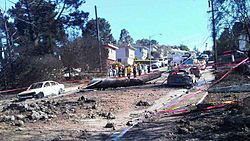PG&E pays the price for deadly explosion — CA doesn’t
Late on a September afternoon in 2010, the big orange California sun was dropping toward Sweeney Ridge just east of the blue-collar town of San Bruno on the San Francisco Peninsula. Families were preparing dinner and catching up on the day’s activities when, at 6:11 p.m., a section of pipe in a 30-inch-diameter intrastate natural gas pipeline owned by Pacific Gas & Electric ruptured near the corner of Glenview Drive and Earl Avenue.
A half-million cubic feet of natural gas gushed out of the pipeline in the first minute after the rupture, and for 94 minutes thereafter, until PG&E finally was able to shut down the flow of natural gas. Almost instantly after the first highly explosive molecules escaped the pipeline’s confines, something ignited it — quite possibly a gas stove heating up dinner in one of the nearby homes.
The resulting explosion and inferno obliterated that home and 37 others and killed eight people. It created a crater, long since filled in, that was big enough to swallow any of the houses destroyed in the explosion. The twisted remains of the ruptured section of pipe, weighing 3,000 pounds and about as long as three elephants lined up nose-to-tail, lay smoking where the explosion hurled it, 100 feet away.
Worse news
The tragic San Bruno pipeline explosion on September 9, 2010 was hardly the worst man-made disaster in California — that dubious honor goes to the failure of the St. Francis Dam in 1928, which killed about 600 people — but it stands as a monument to the longstanding ineptitude of California’s bureaucracies and state Legislature. And last week, two and a half years after explosion, the story of San Bruno’s catastrophe and California’s ineptitude got even worse.
On Tuesday, staffers at the California Public Utilities Commission unveiled their proposed punishment for PG&E: a $2.25 billion fine, the largest ever imposed by the PUC. It includes $300 million that will go directly to the California treasury to be spent on who knows what, and $1.95 billion of required safety upgrades to PG&E’s natural gas distribution system.
The five appointed — not elected — board members of the PUC will decide on the staff proposal this fall, possibly coinciding with the explosion’s third anniversary. They are expected to approve the recommendation, or something close to it. But they are not expected to do anything about who’s just as much at blame as PG&E, because missing from the recommendation is a similarly sized fine for the state of California.
The actions of the state and the PUC are in fact the root cause of the catastrophe, according to the National Transportation Safety Board, which, as the federal regulator of pipelines, investigated the incident. Its accident report found 28 contributing factors to the explosion, two of which stand out.
The first is that the section of pipe that ruptured had defects so pronounced they should have been visible to the PG&E work crews and state inspectors when the pipe was installed in 1954. The second is that, when the PUC adopted new pipeline inspection standards in 1961, it decided against all logic not to apply them to pipelines that were in place prior to that year. All pre-1961 natural gas pipelines in the state, including the one laid seven years earlier under San Bruno, would be grandfathered.
PUC decision
If not for this half-century-old PUC decision, PG&E’s pipeline would have undergone hydrostatic pressure tests that very likely would have revealed the defect under San Bruno. Obviously, industry lobbying, not safety concerns, were behind that decision, because the NTSB report states: “There is no safety justification for the grandfather clause exempting … pipelines from the requirement for post-construction hydrostatic pressure testing.”
The grandfathering happened long before most current legislators and regulators were born, but they’re still not off the hook, because they got a wake-up call less than two years before the San Bruno catastrophe. On Christmas Eve 2008, another PG&E gas pipeline exploded in the Sacramento suburb of Rancho Cordova and killed one person, injured five others and caused severe damage to two homes. Even after that, neither the legislature nor the PUC thought to revisit the grandfathering of the state’s natural gas pipelines.
Clearly, California is culpable for much of the blame for this great tragedy, but it has let itself off the hook — just as it always lets itself off the hook for all the mistakes, missteps and crazily expensive, profoundly useless regulatory crusades it routinely subjects its citizens to.
What a shame.
Laer Pearce, a veteran of three decades of California public affairs, is the author of “Crazifornia: Tales from the Tarnished State.”
Related Articles
CA bans wildlife hunting contests
Wile E. Coyote is smirking. Despite a robust and thriving population, coyotes have just received an unprecedented degree of legal
Goodwin Liu Mangles the Constitution
Gov. Jerry Brown’s Tuesday appointment of Goodwin Liu to the California Supreme Court will continue the state’s lurch to the
Fed Decision Led To 'Tough' CA Budget
JAN. 12, 2011 By CHRISS STREET Ten years from now university economists will analyze Federal Reserve Chairman Ben Bernanke’s recent





